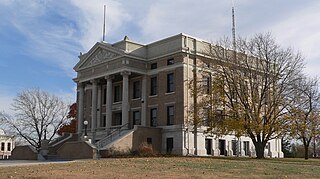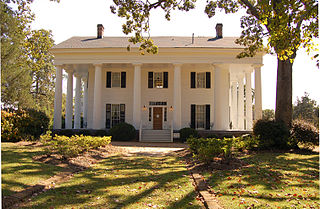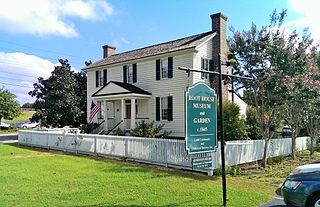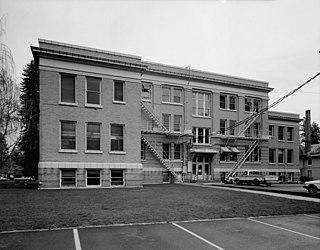
Carnton is a historic plantation home built in 1826 in Franklin, Williamson County, Tennessee, United States. The property, comprising 1,420 acres (5.7 km2), played an important role during and immediately after the Battle of Franklin during the American Civil War. Carnton was situated less than one mile (1.6 km) from the location of the 1864 battle's Union Army eastern flank, and it became the principal temporary field hospital for tending the wounded. More than 1,750 Confederate soldiers lost their lives at Franklin, and on Carnton's back porch four deceased Confederate generals' bodies were laid out for a few hours after the battle. The life of Carrie McGavock, who lived at Carnton during the civil war, was the subject of a best-selling novel in 2005 by Robert Hicks, entitled The Widow of the South. The house was listed on the National Register of Historic Places in 1973, and became a museum managed by The Battle of Franklin Trust, a non-profit organization.

The Hawkins County Courthouse is the seat of county government for Hawkins County, Tennessee, United States, located in the city of Rogersville. It was built in 1836, it is one of six antebellum courthouses still in use in Tennessee, and it is the second oldest courthouse still in use in the state.

The Samuel Penney House is a historic house at 78 Maple Street in Mechanic Falls, Maine. The house was completed in 1902 to design by William R. Miller and is considered the finest example of his residential work. It was originally one of three identical houses that stood side by side until the early 1920s. It was added to the National Register of Historic Places in 2002.

The Jefferson County Courthouse is a historic building in Charles Town, West Virginia, USA. The building is historically notable as the site of two trials for treason: that of John Brown in 1859, and those of unionizing coal miners from Mingo County, West Virginia, a consequence of the Battle of Blair Mountain, whose trials were moved from the southern part of the state in 1922 as a result of a change of venue. It was designated a National Historic Landmark in 2023 for its role in the mining wars.

The Fayette County Courthouse is a historic courthouse building located at 110 East Court Street in Washington Court House, Ohio. On July 2, 1973, it was added to the National Register.

The Courthouse of Crawford County, Ohio, is a landmark of the county seat, Bucyrus, Ohio. The courthouse was built in 1854 on East Mansfield Street by architect Harlan Jones and was added to the National Register of Historic Places on 1985-02-28 as a part of the Bucyrus Commercial Historic District.

The Burn, a house built in 1834, is the oldest documented Greek Revival residence in Natchez, Mississippi. It was built on a knoll to the north of the old town area of Natchez. It was listed on the National Register of Historic Places in 1979.

Madison Historic District in Madison, Georgia is a historic district that was listed in the National Register of Historic Places in 1974. Its boundaries were increased in 1990 and it then encompassed 356 contributing buildings, three other contributing structures, four contributing objects, and three contributing sites.

Paradise Park Historic District is located in Thomasville, Georgia. It was listed on the National Register of Historic Places 1984 with an increase in 2002. It consists of Thomasville's Paradise Park, and properties including 15 contributing buildings and one non-contributing building.

Pawnee County Courthouse in Pawnee City, Nebraska was built in 1911. It was designed by architect William F. Gernandt in Classical Revival style. It was listed on the National Register of Historic Places in 1990.

Antebellum architecture is the neoclassical architectural style characteristic of the 19th-century Southern United States, especially the Deep South, from after the birth of the United States with the American Revolution, to the start of the American Civil War. Antebellum architecture is especially characterized by Georgian, Neo-classical, and Greek Revival style homes and mansions. These plantation houses were built in the southern American states during roughly the 30 years before the American Civil War; approximately between the 1830s to 1860s.

Susina Plantation is an antebellum Greek Revival house and several dependencies on 140 acres near Beachton, Georgia, approximately 15 miles (24 km) southwest of the city of Thomasville, Georgia. It was originally called Cedar Grove. The house is listed on the National Register of Historic Places, and is currently a private residence.

The Brooks County Courthouse in Quitman, Georgia is the historic county courthouse of Brooks County, Georgia. The building is an example of Renaissance Revival and Romanesque Revival architecture. It underwent extensive renovations in 1892. It was listed on the National Register of Historic Places in 1980.

The Augustine Hansell House, also known as Jeffries House, is a historic home of exceptional quality in Thomasville, Georgia, United States. It was designed by architect John Wind, the leading architect of Thomas County, in Greek Revival style. A 1+1⁄2-story cottage, it was built during 1852–53 for Augustine Hansell. Hansell, who later (1869) was mayor of Thomasville, was a judge of the Superior Court of the Southern Judicial Circuit. He also organized the Thomas Reserves and was commander of a militia company of Thomas County. He was a lieutenant in the Thomas Reserves.

The Northwest Marietta Historic District is a 230-acre (93 ha) historic district in Marietta, Georgia that was listed on the National Register of Historic Places in 1975. It includes Late Victorian, Greek Revival, Plantation Plain, and other architecture. The district includes an area in downtown Marietta, with the southernmost point being south of Whitlock Avenue on McDonald Street, and runs out Kennesaw Avenue to Noses Creek in the northwest.

The Kootenai County Courthouse, located at 501 Government Way in Coeur d'Alene, is the county courthouse serving Kootenai County, Idaho. The courthouse was built in 1925–26. Spokane architect Julius A. Zittle designed the Georgian Revival building. A portico at the entrance features an entablature, frieze, and balcony supported by two Doric columns. The second-floor front windows are arched and have terra cotta ornamentation; brick pilasters separate the windows. The building is topped by a cornice and a brick parapet; a decorative Idaho state seal is located on the parapet above the entrance.

The Belmont Library is the public library of Belmont, New Hampshire. It is located at 146 Main Street, in an architecturally distinguished single-story brick Colonial Revival structure designed by Wells & Hudson and built in 1927-28.

The Mill Agent's House is a historic house at Maine State Route 32 and Priest Hill Road in North Vassalboro, Maine. Built in 1851 for the manager overseeing the village's textile mill, it is a large and distinctive example of Greek Revival architecture. It was listed on the National Register of Historic Places in 1983.

The Follett House is a historic house at 63 College Street in Burlington, Vermont. Built in 1840 for a prominent local businessman, it is the last surviving grand 19th-century lakeside mansion in the city, and one of the state's finest examples of Greek Revival architecture. It was listed on the National Register of Historic Places in 1972. It has seen commercial and institutional uses since 1885.

The Governor Luther Hall House is a historic residence located at 1515 Jackson Street in Monroe, Ouachita Parish, Louisiana. It was constructed in 1906 by its owner, Luther E. Hall, who would later serve as the 35th Governor of Louisiana.




















